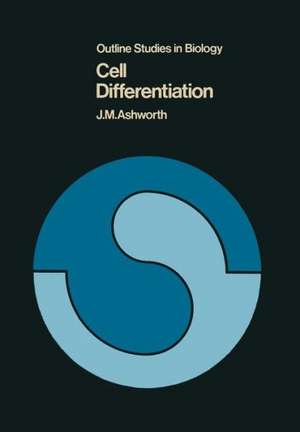Cell Differentiation: Outline Studies in Biology
Autor J. M. Ashworthen Limba Engleză Paperback – 24 mai 1973
Din seria Outline Studies in Biology
-
 Preț: 375.07 lei
Preț: 375.07 lei -
 Preț: 375.07 lei
Preț: 375.07 lei -
 Preț: 375.62 lei
Preț: 375.62 lei -
 Preț: 375.07 lei
Preț: 375.07 lei -
 Preț: 375.62 lei
Preț: 375.62 lei -
 Preț: 375.62 lei
Preț: 375.62 lei -
 Preț: 375.07 lei
Preț: 375.07 lei -
 Preț: 375.84 lei
Preț: 375.84 lei -
 Preț: 375.07 lei
Preț: 375.07 lei -
 Preț: 375.45 lei
Preț: 375.45 lei -
 Preț: 375.07 lei
Preț: 375.07 lei -
 Preț: 375.62 lei
Preț: 375.62 lei - 15%
 Preț: 637.28 lei
Preț: 637.28 lei -
 Preț: 375.84 lei
Preț: 375.84 lei -
 Preț: 375.62 lei
Preț: 375.62 lei - 5%
 Preț: 357.23 lei
Preț: 357.23 lei -
 Preț: 375.45 lei
Preț: 375.45 lei -
 Preț: 375.07 lei
Preț: 375.07 lei
Preț: 375.84 lei
Nou
Puncte Express: 564
Preț estimativ în valută:
71.94€ • 74.82$ • 60.28£
71.94€ • 74.82$ • 60.28£
Carte tipărită la comandă
Livrare economică 13-27 martie
Preluare comenzi: 021 569.72.76
Specificații
ISBN-13: 9780412117602
ISBN-10: 0412117606
Pagini: 64
Ilustrații: 64 p. 6 illus.
Dimensiuni: 170 x 244 x 4 mm
Greutate: 0.13 kg
Editura: SPRINGER NETHERLANDS
Colecția Springer
Seria Outline Studies in Biology
Locul publicării:Dordrecht, Netherlands
ISBN-10: 0412117606
Pagini: 64
Ilustrații: 64 p. 6 illus.
Dimensiuni: 170 x 244 x 4 mm
Greutate: 0.13 kg
Editura: SPRINGER NETHERLANDS
Colecția Springer
Seria Outline Studies in Biology
Locul publicării:Dordrecht, Netherlands
Public țintă
ResearchCuprins
1 Introduction.- 2 Strategy and tactics.- 3 Model systems, the reductionist approach.- 3.1 Bacteriophage.- 3.2 Enzyme induction in bacteria.- 3.3 Spore formation in bacteria.- 3.4 Are prokaryotes good models for eukaryotes?.- 3.5 The cellular slime mould Dictyostelium discoideum.- 3.6 Tissue culture cells.- 3.7 Metamorphosis.- References.- 4 Special systems, the classical approach.- 4.1 Chromosome structure and function.- 4.2 RNA synthesis.- 4.3 Protein synthesis.- 4.4 Protein degradation.- 4.5 Protein modification.- 4.6 Metabolism.- Summary.- References.- Suggestions for further reading.








